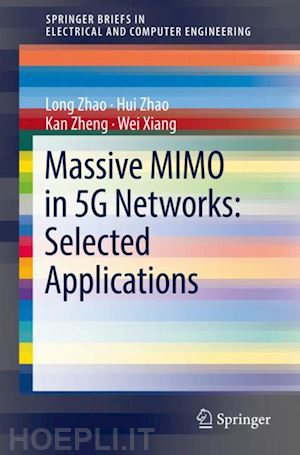

Questo prodotto usufruisce delle SPEDIZIONI GRATIS
selezionando l'opzione Corriere Veloce in fase di ordine.
Pagabile anche con Carta della cultura giovani e del merito, 18App Bonus Cultura e Carta del Docente
This SpringerBrief focuses mainly on the basic theory and applications of massive MIMO in 5G networks. The significance of massive MIMO for 5G or future communications is first briefly discussed. Then, the basic theory of massive MIMO technology is comprehensively analyzed, i.e., a variety of 5G scenarios and their improvements are described when massive MIMO is taken into account. Art physical-layer techniques and various networking techniques for interference mitigation and resource scheduling are introduced as well. This SpringerBrief also examines the selected applications of massive MIMO in 5G networks, i.e., massive MIMO-aided millimeter communications and energy transfer. The physical-layer design, multiple access control (MAC) mechanism and networking techniques are discussed for millimeter-wave communications aided by massive MIMO technology. Then, massive MIMO is covered for hybrid information and energy transfer. A downlink precoder and a uplink pilot scheme is proposed for single cell networks, and both non-cooperative and cooperative energy transfer in multi-cell are presented.
Communication researchers in the area of MIMO technology, as well as researchers and practitioners working in millimeter communications and energy transfer seeking new research topics, and topic areas with communication system design, centralized and distributed algorithms, will find this brief useful as a reference. Advanced-level students studying communication engineering will also find this book useful as a secondary text.
1.1 5G Brief
1.1.1 5G Requirements
1.1.2 5G Technology
1.2 MIMO Technology
1.2.1 MIMO
1.2.2 Massive MIMO
1.3 Aim of Monograph
References
2 Massive MIMO Technology (about 25 pages)2.1 Application Scenarios
2.1.1 Homogeneous Network Scenarios
2.1.2 Heterogeneous Network Scenarios
2.2 Physical-Layer Performance
2.2.1 Spectrum Efficiency
2.2.2 Energy Efficiency
2.2.3 Reliability
2.3 Networking Technology
2.3.1 Inter-Cell Interference Coordination
2.3.1 Scheduling Strategy
2.4 Summary
References
3 Massive MIMO-Aided Millimeter Communication Networks (about 20 pages)3.1 Background
3.2 Deployment of Millimeter Communications
3.2.1 Typical Deployment Scenarios
3.2.2 Frame Structure
3.3 MAC and Networking Design
3.3.1 Routing in multi-hop HetSNets
3.3.2 Access control and interference coordination3.3.3 mm-wave Softcell Concept
3.4 Performance and Discussions
3.5 Summary
References
4 Massive MIMO-Assistant Energy Transfer Networks(about 20 pages)4.1 Background
4.2 Downlink Hybrid Information and Energy Transfer
4.2.1 Downlink HIET System Model
4.2.2 Power Allocation Problem for HIET System
4.3 Power Allocation of Single Cell Scenario
4.3.1 Power Allocation with Perfect CSI
4.3.2 Power Allocation with Estimated CSI
4.3.3 Performance Evaluation4.4 Cooperative Energy Transfer of Multi-Cell Scenario
4.4.1 Centralized Energy Precoder
4.4.2 Distributed Energy Precoder
4.4.3 Performance Evaluation
4.5 Summary
References
5 Conclusion and Outlook(about 5 pages)5.1 Conclusion
5.2 Future Research Directions
References











Il sito utilizza cookie ed altri strumenti di tracciamento che raccolgono informazioni dal dispositivo dell’utente. Oltre ai cookie tecnici ed analitici aggregati, strettamente necessari per il funzionamento di questo sito web, previo consenso dell’utente possono essere installati cookie di profilazione e marketing e cookie dei social media. Cliccando su “Accetto tutti i cookie” saranno attivate tutte le categorie di cookie. Per accettare solo deterninate categorie di cookie, cliccare invece su “Impostazioni cookie”. Chiudendo il banner o continuando a navigare saranno installati solo cookie tecnici. Per maggiori dettagli, consultare la Cookie Policy.